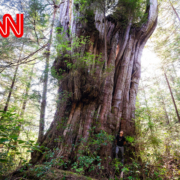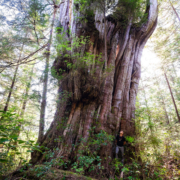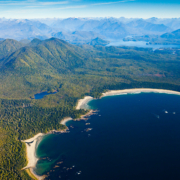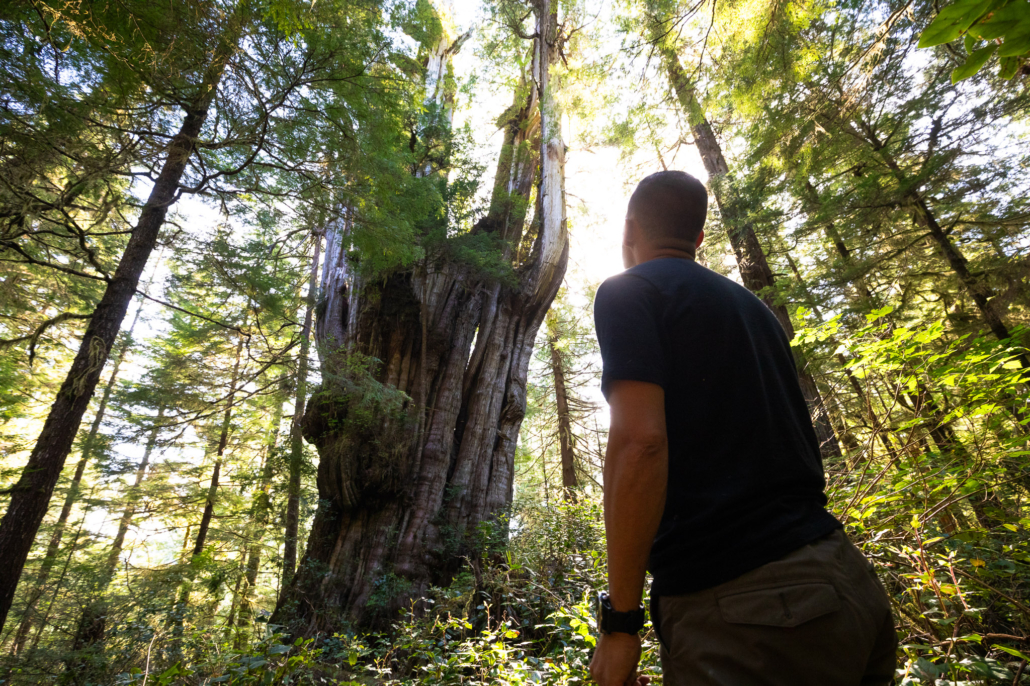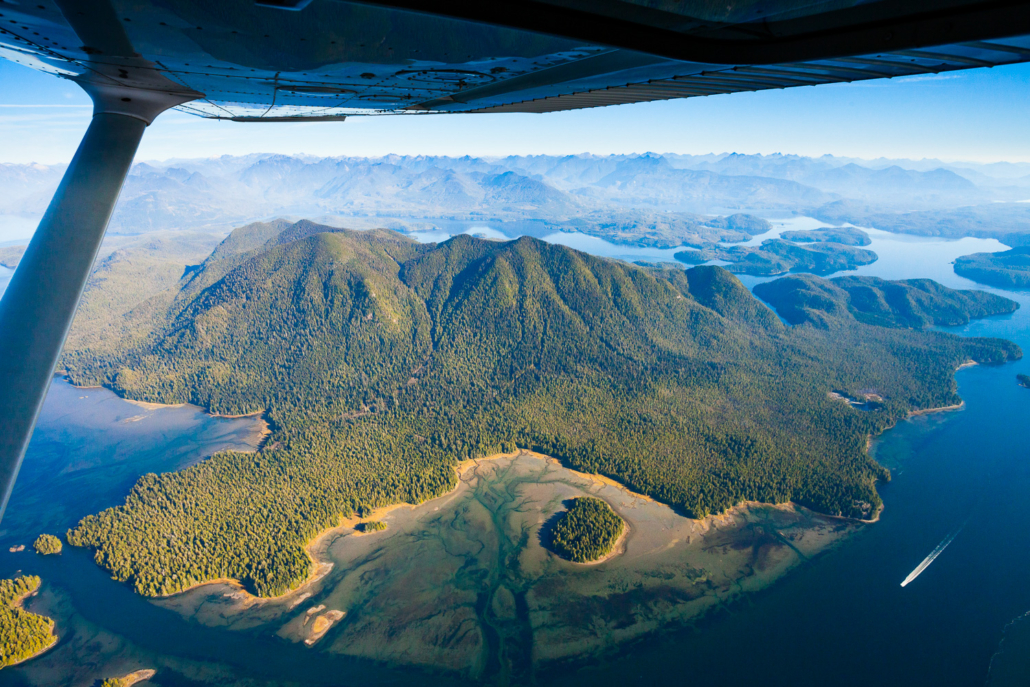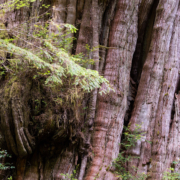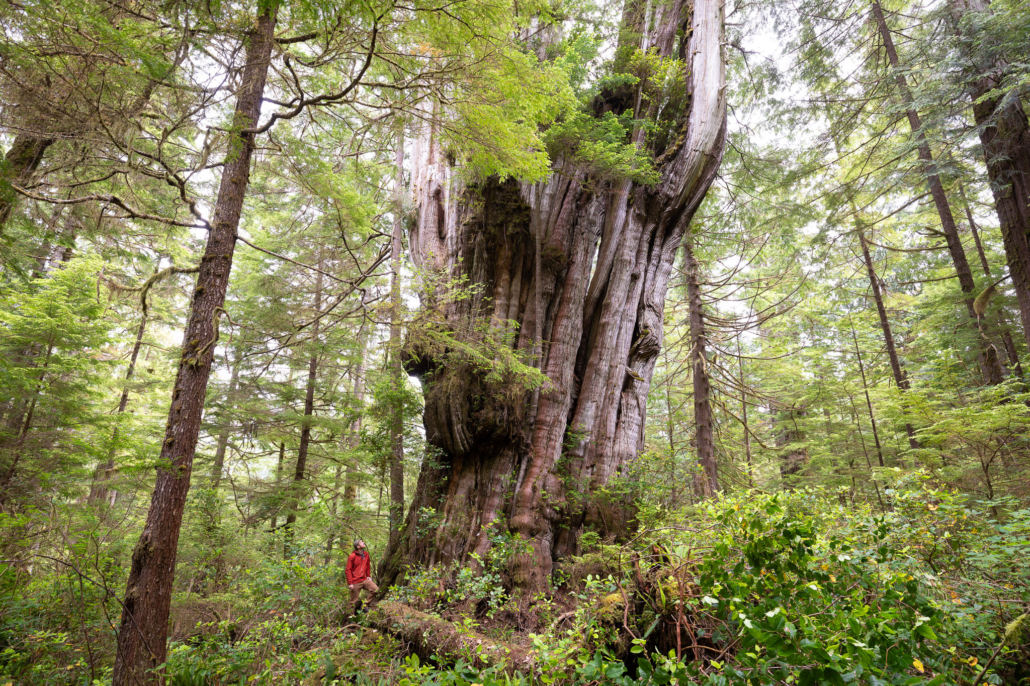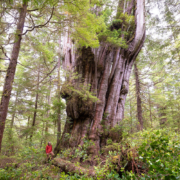October 8, 2023
By Cathy Free
The Washington Post – Read the original article.
Tree Hunter TJ Watt found the cedar in British Columbia standing 151 feet tall and about 17 feet in diameter
TJ Watt has spent half his life as a forest explorer, a self-described “tree hunter” in British Columbia. He wades deep into endangered forests to find pristine towering trees that are hundreds of years old and massively wide but have never been photographed or documented.
He draws attention to the enormous old-growth trees to show the importance of saving the natural wonders from logging.
The day he approached a gargantuan western red cedar he’d been trekking with a friend for several hours in a remote area on Flores Island in Clayoquot Sound in Ahousaht territory off the west coast of Vancouver Island.
“After bush whacking for a while in the woods, we started to see some really large cedars, then suddenly, up ahead, we could see the looming trunk of this giant tree,” he said. “It was so large that at first, we almost thought we were looking at two trees.”
As he drew closer to the tree, Watt said he was overcome with disbelief: He was dwarfed by a tree standing 151 feet tall and 17 and a half feet in diameter.
The tree, believed to be more than 1,000 years old, was the find of a lifetime. It’s one of the largest old-growth cedars ever documented in British Columbia, Watt said.
“I feel humbled every time I think about it,” said Watt, 39. “I nicknamed it ‘The Wall,’ because it can only be described as a literal wall of wood.”
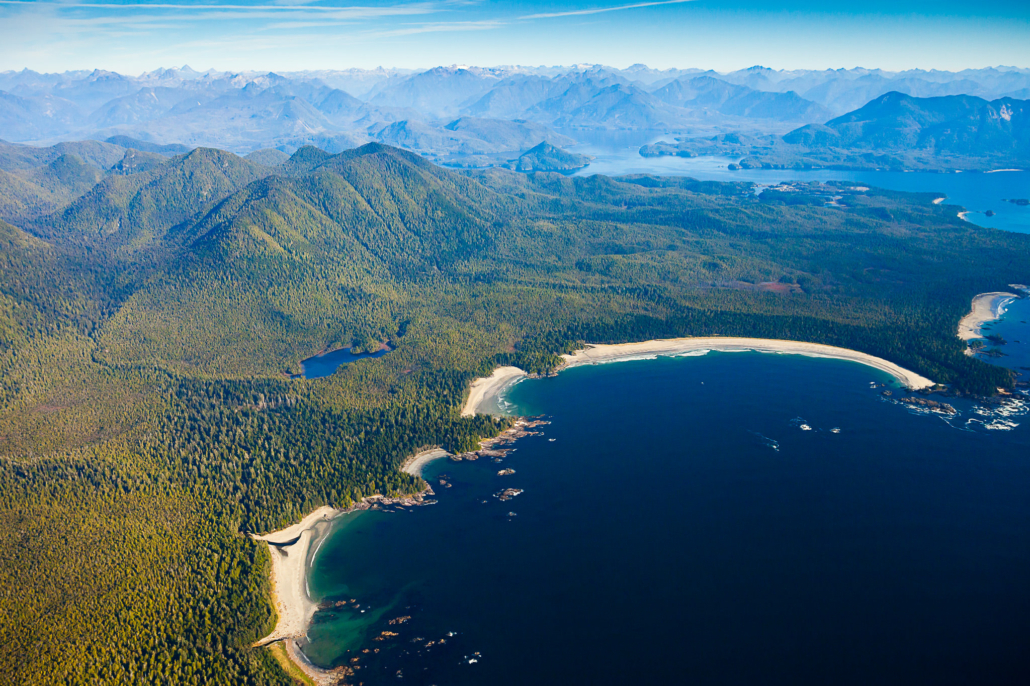
An aerial view over the old-growth forests of Flores Island in Ahousaht territory, Clayoquot Sound, British Columbia. (TJ Watt/Ancient Forest Alliance)
He said this was a first in his 20 years of tree hunting.
“I’ve found thousands and thousands of trees, and I’ve shot hundreds of thousands of photos of old-growth forests,” he said. “But I’ve never seen a tree as impressive as this one.”
Watt felt humbled by the discovery.
“It was incredible to stand before it,” he said. “I’d describe it as a freak of nature because it actually gets wider as it gets taller. As I looked up at it, I felt a sense of awe and wonder.”
He found the tree in June 2022, but he didn’t alert the public about it until the end of July this year because he wanted to make sure the tree was thoroughly documented, and also wanted input from Ahousaht First Nation members who have lived in the territory for thousands of years.
“It was decided that we should keep the tree’s location a secret because these are sensitive areas, and everything could get pretty trampled if word got out where to find it,” Watt said.
The Ahousaht First Nation has about 2,400 members, with 1,100 living on Flores Island, said Tyson Atleo, a hereditary representative for the nation, someone who is a caretaker of the nation’s cultural traditions and history.
Atleo said he didn’t know about the colossal cedar until Watt took him to see it.
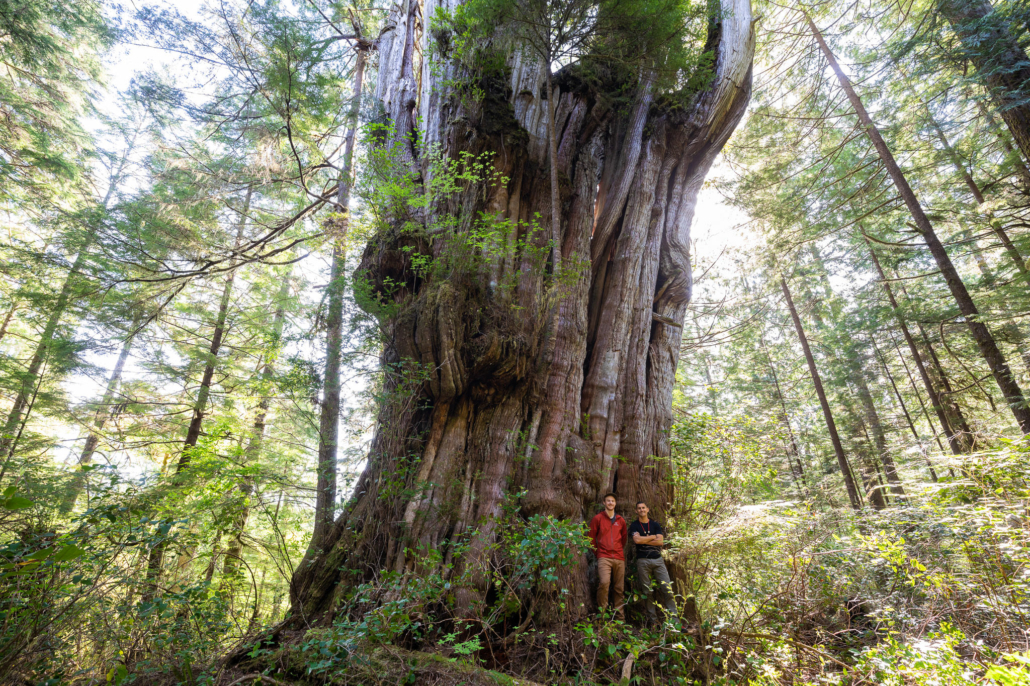
Ancient Forest Alliance photographer TJ Watt and Ahousaht hereditary representative Tyson Atleo with the ancient western red cedar tree that is among the largest ever documented in British Columbia. (TJ Watt/Ancient Forest Alliance)
“The tree leaves you with a sense of wonder about the natural world and the universe,” said Atleo, 37. “There is so much about that tree and the life it upholds that we will never understand. When you look at it, it hits you like that.”
He said the Ahousaht people would have admired it over the ages.
“People would have seen this tree for hundreds of years — my people would have interacted with it for as long as it’s been here,” he said. “Today we covet these large trees because there are so few of them left.”
Canada’s largest tree, widely recognized as the Cheewhat Giant, was first documented in 1988 measuring about 19 feet in diameter and 182 feet in height, according to the Ancient Forest Alliance. It’s located in the protected Pacific Rim National Park Reserve.
While it is protected, about 80% of the original, productive old-growth forests on Vancouver Island have been logged, satellite photos show, according to the Ancient Forest Alliance.
Too many old-growth trees have been cut down for timber rather than being recognized for their value providing habitat for wildlife and storing vast amounts of carbon, Atleo said. An old-growth forest is typically described as a forest containing trees that have developed over hundreds of years, with unique characteristics that are not found in younger forests.
British Columbia has a plan to protect its old-growth forests, but many conservationists have found government implementation of the plan to be slow, said Watt.
“There’s still a lot of work to be done,” he said.
Atleo said his nation now operates an eco-cultural tour company to showcase some of the territory’s old-growth trees (the tree found by Watt won’t be included), and his community is working to get financing to save more ancient forests. The nation has protected 80 percent of its Clayoquot Sound lands on Vancouver Island’s western coast, and the nation will now protect the large tree that Watt documented, he said.
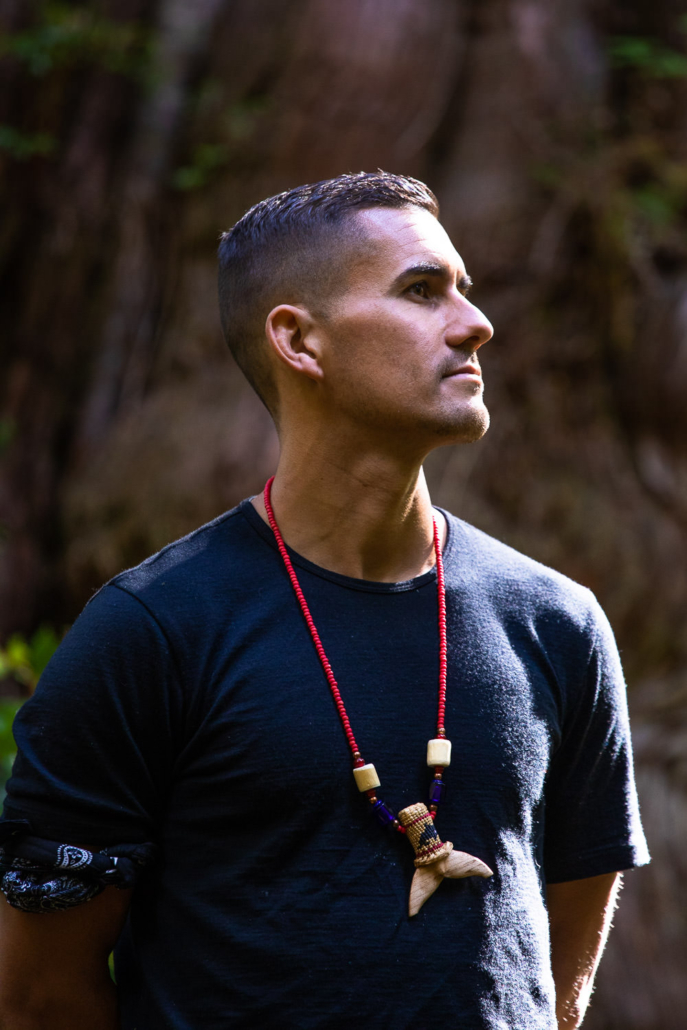
Tyson Atleo is a hereditary representative of the Ahousaht First Nation. (TJ Watt/Ancient Forest Alliance)
“We need to acknowledge that our community is reliant on some [logging] employment in the forest sector, but we are envisioning doing it in a better and new way,” Atleo said. “TJ’s work is helping raise public awareness and inspiring people to feel connected to these forests.”
Watt said he undertook the Flores Island tree-hunting expedition as an explorer for National Geographic and the Royal Canadian Geographical Society, through a grant provided by the Trebek Initiative, a group that funds photographers and others who contribute to Canadian wildlife projects.
Watt shares photos of the giant trees on social media and his Ancient Forest Alliance website.
“I was excited to post the photos because I knew people would be as blown away by the tree as I was,” he said, adding that he also shared some of his first photos of the enormous cedar with the Canadian Broadcasting Company.
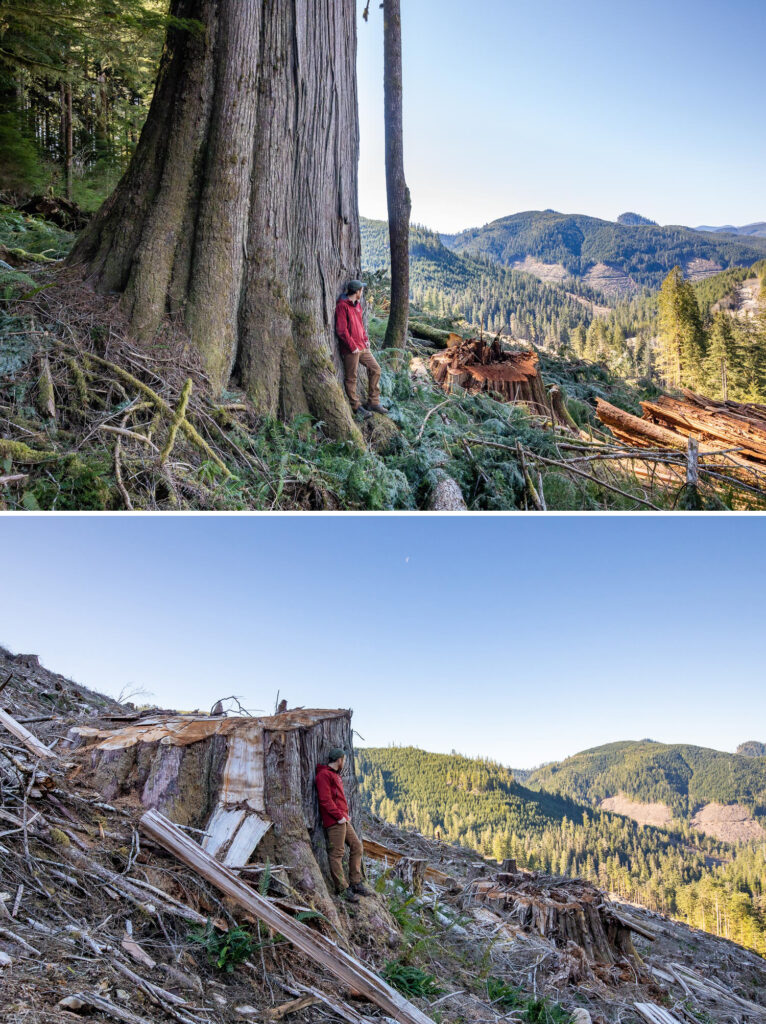
These 2020 photos show TJ Watt with a giant red cedar tree before and after it was cut down by loggers in the Caycuse watershed in Ditidaht First Nation territory on southern Vancouver Island. The tree was close to 150 feet tall and 10 feet wide in diameter, Watt said, adding that he hopes to save other old-growth trees from the same fate through his conservation photography work. (TJ Watt/Ancient Forest Alliance)
Watt lives in Victoria, where he grew up in the small town of Metchosin, climbing trees and playing in the woods, he said.
“It was a lush place with forested hillsides — you had the fog rolling through the forest, sunbeams coming in and moss hanging off everything,” he said.
Watt honed his photography skills, he said, and in 2010 he co-founded the Ancient Forest Alliance nonprofit to both document the trees and try to preserve them.
He said he’s now in the woods every chance he gets to explore and photograph some of the most rugged landscapes in British Columbia.
“I look at maps and study satellite imagery of forests to pick an area, then I pack my bags with cameras and communication gear and that’s when the fun starts,” Watt said.
He is often exploring for days at a time and usually takes somebody with him.
“We’ll drive on the back roads, then get out and walk into the woods, and that’s the magic of it,” he said.
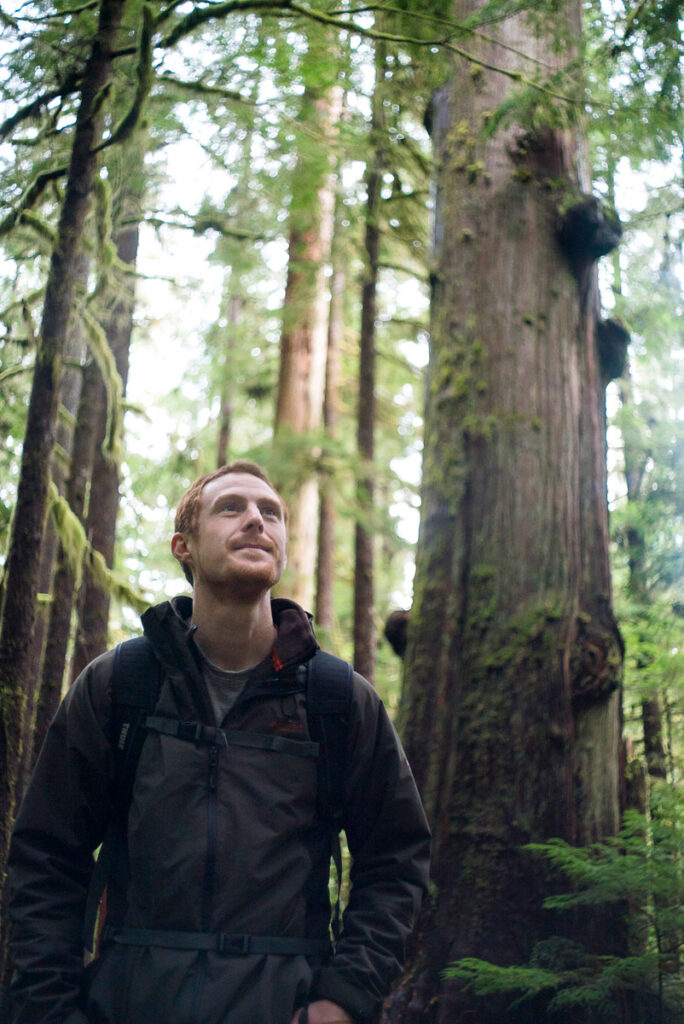
TJ Watt grew up with forests in his backyard, and he now spends most of his time documenting old-growth trees. (TJ Watt/Ancient Forest Alliance)
Although he’d visited Flores Island before, he said he was looking forward to exploring more of the island’s 96 square miles of forests. He’s still stunned by what he found there.
“I know I’m not the first person to see this big tree — the Ahousaht people have inhabited this area since time immemorial,” he said. “But I feel honored in modern times to be the first to notice and document it.”


